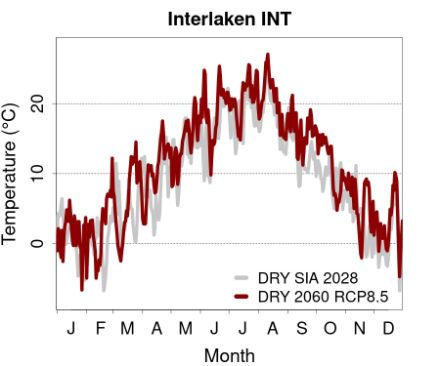Service Navigation
Search
According to the CH2018 Climate Scenarios for Switzerland, heatwaves are set to increase significantly in frequency, intensity and duration as climate change progresses. This also has implications for the building sector. For the current climate, the climate data from the technical specification SIA 2028:2010 form an important basis for assessing thermal comfort in building interiors as well as buildings' energy requirements. Supplementing the technical specification SIA 2028:2010 data with climate scenarios will also allow building designers to assess the indoor climate of the future. These data for the future were financed and compiled in joint projects by the Federal Office of Meteorology and Climatology (MeteoSwiss), the Canton of Zurich Building Department, the Federal Office for the Environment (FOEN), the Swiss Society of Engineers and Architects (SIA) and Lucerne University of Applied Sciences and Arts (HSLU).

Hourly climate scenarios
As part of the 'Climate-adapted construction – Foundations for the future' project, MeteoSwiss has created hourly basic data representing the possible future climate at locations across Switzerland, based on the CH2018 Climate Scenarios. Hourly, physically consistent data for the future on temperature, humidity, wind and solar radiation have been calculated. These represent typical years (known as 'design reference years' or DRYs) and warm summer years ('1-in-10-year events') in the future. The data are available at 45 stations for the periods 2020–2049 and 2045–2074, and are based on two different developments in global greenhouse gas emissions: 'no climate change mitigation' (RCP8.5) and 'concerted climate change mitigation efforts' (RCP2.6). The work is based on the local datasets from CH2018, with the urban heat island effect also being considered in the case of four cities. The new data are freely available at https://map.geo.admin.ch. Six future years are given for each station.

Basis for building simulations
In collaboration with the pilot project A.15 'Up-to-date climate data for building designers', part of the 'Adaptation to climate change' pilot programme, the newly created basic data were iteratively tested using building simulations. This collaboration resulted in key recommendations for building designers on how to use the data correctly. The test simulations also provide initial insights into thermal comfort for various building types. The climate data can be used in different ways in building simulations, depending on whether the objective is to verify summer heat protection, to determine energy requirements or to design building services.
The test simulations yielded fundamental insights into future energy requirements and expected thermal comfort in the various building categories – residential, administrative and schools – at different locations. Significant regional differences also emerged from the results, for example for buildings on the Swiss Plateau, south of the Alps, at elevated Alpine locations or in urban or rural areas. These may well lead to divergent strategies in building design.
Key contribution to climate change adaptation
By using these datasets, building designers will contribute significantly to reducing future impairments of user comfort and performance and to ensuring the optimal design of buildings' technical services. The new Switzerland-wide data supplement the existing data from the technical specification SIA 2028:2010, ensuring that buildings constructed today are also fit for the climate of tomorrow.